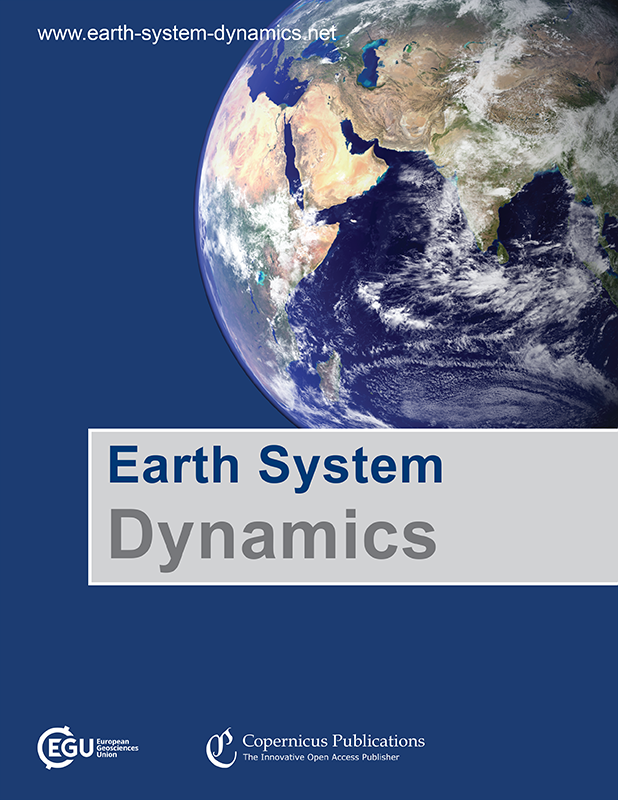欧洲阿尔卑斯山地表异时空隆升对区域气候和降水氧同位素组成的影响
IF 7.2
2区 地球科学
Q1 GEOSCIENCES, MULTIDISCIPLINARY
引用次数: 0
摘要
摘要本研究介绍了区域气候和降水氧同位素组成(δ18Op)对不同沿线地形演变情景的模拟响应。进行这些模拟是为了确定之前假设的西阿尔卑斯山和东阿尔卑斯山的非同步地表隆升是否会在地质记录中产生足够大和足够明显的δ18Op信号,从而可以用稳定同位素古高程测量法检测出来。我们利用水同位素追踪大气环流模式 ECHAM5-wiso 进行了一系列地形敏感性实验。地形情景是由两个自由参数的变化产生的,即 (1) 中西部阿尔卑斯山的海拔高度和 (2) 东部阿尔卑斯山的海拔高度。结果表明,在非同步隆升情景下,阿尔卑斯山沿线的Δ18Op值(即低海拔和高海拔地点的Δ18Op值之差)最多为-8‰,这主要是由于地貌降水量和绝热失速率的变化导致了近地表变量的局部变化。这些模拟的 Δδ18Op 值表明,预期的同位素信号将足够重要,足以在地质档案中保存和测量。此外,低海拔地点的模拟δ18Op差异在1‰-2‰之间,这支持了δ-δ古高程测量方法的使用,并强调了在远场低海拔地点取样以区分不同地表隆起情况的重要性。δ18Op随海拔高度的变化率("同位素失效率")随地形构造和地表隆升程度的不同而变化。大多数变化是显著的(如-1.04 ‰ km-1,斜率误差为±0.09 ‰ km-1),而其他变化则在统计不确定性范围之内(如-0.15 ‰ km-1,斜率误差为±0.13 ‰ km-1)。这些结果还强调了大气环流模式的合理变化以及与之相关的水汽输送路径变化对阿尔卑斯山地形变化的响应。这些大规模的大气动力学变化会使稳定同位素古高程测量的基本假设复杂化,因此需要与古气候建模相结合,以确保准确重建阿尔卑斯山的古高程。本文章由计算机程序翻译,如有差异,请以英文原文为准。
The effects of diachronous surface uplift of the European Alps on regional climate and the oxygen isotopic composition of precipitation
Abstract. This study presents the simulated response of regional climate and the oxygen isotopic composition of precipitation (δ18Op) to different along-strike topographic evolution scenarios. These simulations are conducted to determine if the previously hypothesized diachronous surface uplift in the Western and Eastern Alps would produce δ18Op signals in the geologic record that are sufficiently large and distinct to be detected using stable isotope paleoaltimetry. We present a series of topographic sensitivity experiments conducted with the water-isotope-tracking atmospheric general circulation model (GCM) ECHAM5-wiso. The topographic scenarios are created from the variation of two free parameters, (1) the elevation of the Western–Central Alps and (2) the elevation of the Eastern Alps. The results indicate Δδ18Op values (i.e., the difference between δ18Op values at the low- and high-elevation sites) of up to −8 ‰ along the strike of the Alps for the diachronous uplift scenarios, primarily due to changes in orographic precipitation and adiabatic lapse rate driven localized changes in near-surface variables. These simulated magnitudes of Δδ18Op values suggest that the expected isotopic signal would be significant enough to be preserved and measured in geologic archives. Moreover, the simulated slight δ18Op differences of 1 ‰–2 ‰ across the low-elevation sites support the use of the δ–δ paleoaltimetry approach and highlight the importance of sampling far-field low-elevation sites to differentiate between the different surface uplift scenarios. The elevation-dependent rate of change in δ18Op (“isotopic lapse rate”) varies depending on the topographic configuration and the extent of the surface uplift. Most of the changes are significant (e.g., −1.04 ‰ km−1 change with slope error of ±0.09 ‰ km−1), while others were within the range of the statistical uncertainties (e.g., −0.15 ‰ km−1 change with slope error of ±0.13 ‰ km−1). The results also highlight the plausible changes in atmospheric circulation patterns and associated changes in moisture transport pathways in response to changes in the topography of the Alps. These large-scale atmospheric dynamics changes can complicate the underlying assumption of stable isotope paleoaltimetry and therefore require integration with paleoclimate modeling to ensure accurate reconstruction of the paleoelevation of the Alps.
求助全文
通过发布文献求助,成功后即可免费获取论文全文。
去求助
来源期刊

Earth System Dynamics
GEOSCIENCES, MULTIDISCIPLINARY-
CiteScore
13.20
自引率
5.50%
发文量
61
审稿时长
36 weeks
期刊介绍:
Earth System Dynamics (ESD) is a not-for-profit international scientific journal committed to publishing and facilitating public discussion on interdisciplinary studies focusing on the Earth system and global change. The journal explores the intricate interactions among Earth's component systems, including the atmosphere, cryosphere, hydrosphere, oceans, pedosphere, lithosphere, and the influence of life and human activity. ESD welcomes contributions that delve into these interactions, their conceptualization, modeling, quantification, predictions of global change impacts, and their implications for Earth's habitability, humanity, and the future dynamics in the Anthropocene.
 求助内容:
求助内容: 应助结果提醒方式:
应助结果提醒方式:


